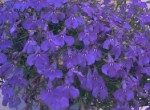 The bright indigo blue flowers of bedding lobelia in six packs at garden centers always catch my eye and dance in my mind in images of the splendid border I would like to create but never quite manage. The blue color is terrific with many other bedding plants such as hot pink portulaca, yellow marigolds, and white sweet alyssum and you will frequently see containers and public plantings that utilize this versatile blue color. Technically a tender perennial, it disdains heat and humidity and so is grown in much of this country as an annual. Cultivars vary in both heat resistance and color but heat and humidity is the enemy of lobelia and will ultimately take its toll. It can be grown from seed but in most areas is better purchased as a bedding plant in six packs in spring so as to enjoy the longest possible bloom period. In the South the plants grow lanky by June along with the pansies and should be removed or sheared back in hopes of a Fall bloom. Upright forms are wonderful edgers, and can be used in rock gardens and the front of borders; trailing forms are effective in hanging baskets, and both forms are successful in containers.
The bright indigo blue flowers of bedding lobelia in six packs at garden centers always catch my eye and dance in my mind in images of the splendid border I would like to create but never quite manage. The blue color is terrific with many other bedding plants such as hot pink portulaca, yellow marigolds, and white sweet alyssum and you will frequently see containers and public plantings that utilize this versatile blue color. Technically a tender perennial, it disdains heat and humidity and so is grown in much of this country as an annual. Cultivars vary in both heat resistance and color but heat and humidity is the enemy of lobelia and will ultimately take its toll. It can be grown from seed but in most areas is better purchased as a bedding plant in six packs in spring so as to enjoy the longest possible bloom period. In the South the plants grow lanky by June along with the pansies and should be removed or sheared back in hopes of a Fall bloom. Upright forms are wonderful edgers, and can be used in rock gardens and the front of borders; trailing forms are effective in hanging baskets, and both forms are successful in containers.
Type: Tender perennial treated as annual.
Bloom: Small purple to blue flowers with white or yellow throat and extended stamens spring to frost in cool areas, spring and fall in warm areas; cultivars are available in pink, light blue, red, and white.
Size: 6-8” H x 6-12” W.
Light: Full sun; afternoon shade in South.
Soil: Organically rich, cool, evenly moist, well-drained.
Fertilizer: Apply fertilizer every two weeks.
Hardiness: Zones 10-11.
Care: Shear back when plants become lanky.
Pests and Diseases: None of importance all though die back due to heat intolerance is a major problem in warm areas.
Propagation: Seed.
Companion plants: Yellow marigolds, sweet alyssum, bacopa, impatiens, wax begonias, wishbone flower, love-in-the-mist, flossflower.
Outstanding Selections:
 ‘Crystal Palace’ (dark blue flowrs with slightly bronzed foliage)
‘Crystal Palace’ (dark blue flowrs with slightly bronzed foliage) ‘Periwinkle Blue’ (relatively heat tolerant)
‘Periwinkle Blue’ (relatively heat tolerant)